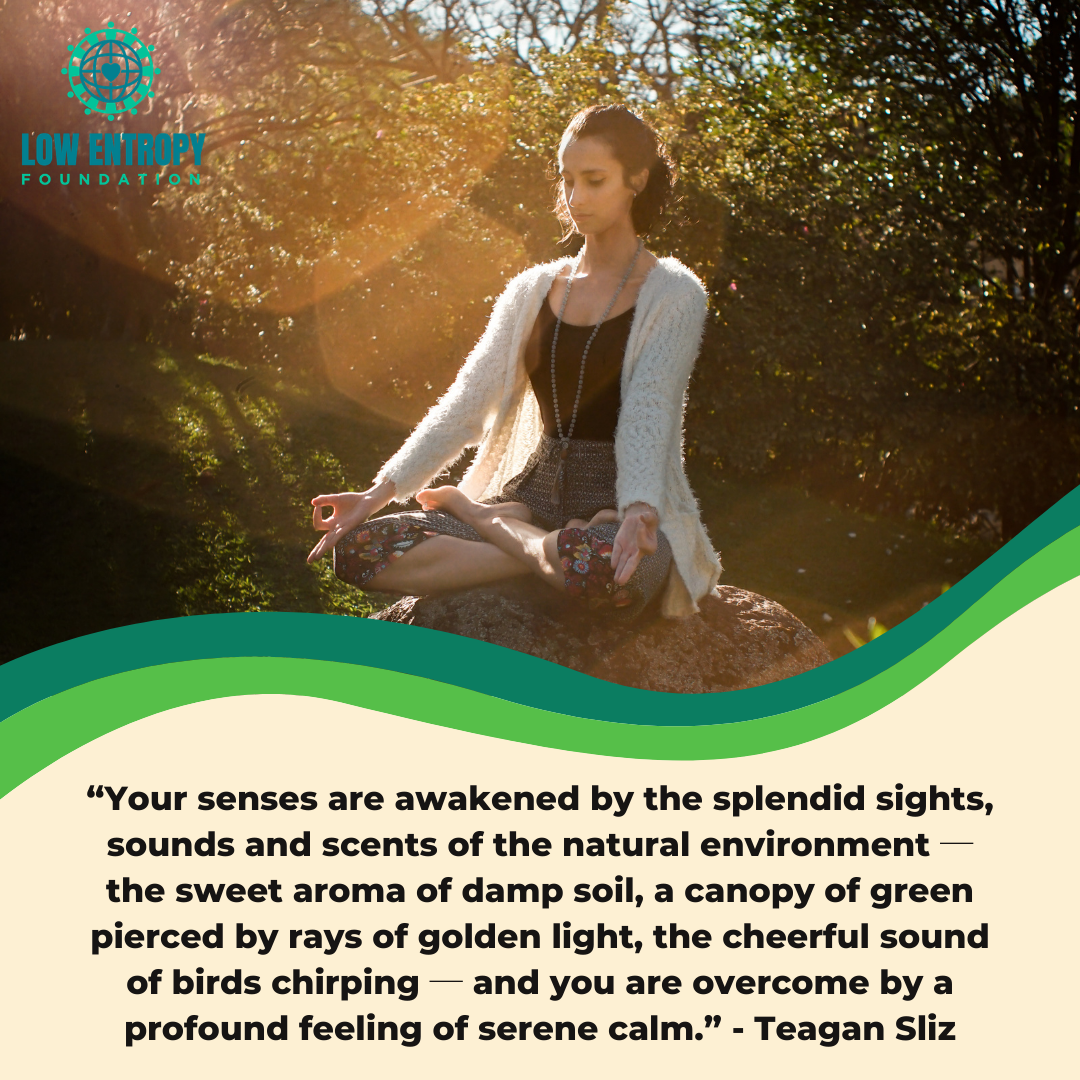Even if you aren’t the outdoorsy type, being in nature – just for a little while – might still be beneficial to your mental health. Low Entropy Volunteer Writer Teagan Sliz writes on the growing awareness of the natural world’s curative properties.
Your neck muscles unscrunch, the tightness in your chest begins to subside, your thoughts become clear and your mind tranquil. All you have done is stepped foot into a forest, waded into a lake or merely wandered into your backyard. Your senses are awakened by the splendid sights, sounds and scents of the natural environment ─ the sweet aroma of damp soil, a canopy of green pierced by rays of golden light, the cheerful sound of birds chirping ─ and you are overcome by a profound feeling of serene calm.
For millennia, humans have intuitively known that nature has restorative effects on one’s well-being. After all, for the majority of our species’ history, our lives have been closely intertwined with the natural world. This is why we go on walks to clear our minds and travel to lake houses, campgrounds or tropical beaches in order to “reset.” In recent decades, however, science has begun to confirm and explain what we intuitively know to be true.
Shinrin-yoku is a Japanese term which translates to “forest bathing.” In his 2018 article for Time Magazine, Dr. Qing Li, who studies the health benefits of forest bathing, describes this practice as “bathing in the forest atmosphere, or taking in the forest through our senses.” Dr. Li explains that the purpose of forest bathing is to bridge the gap between us and the natural world by simply being in nature ─ connecting with it through our senses of sight, hearing, taste, smell and touch. Through his research, Dr. Li has found that forest bathing reduces pulse rate, increases vigor and relaxation, and decreases feelings of anxiety, depression and fatigue. Dr. Li even found that these nature walks produce elevated levels of Natural Killer or NK cells in the immune system, which fight tumors and infections.
What is more intriguing is just how easy it is to reap the benefits of the miracle drug that is nature. In a 2019 study led by Mathew White of the European Centre for Environment & Human Health, it was concluded that it takes a mere two hours a week of time spent in green spaces for individuals to report higher levels of good health and well-being.
These findings come as no surprise to me. Growing up, I was fortunate enough to have a cottage to which my family would make weekend trips in the summer months. On our trips north, as the distance between us and the city grew and we entered into the rural farmlands that sat quietly just north of the Greater Toronto Area, I remember feeling great elation as I sat in the back seat knowing what was to come. My memories of the cottage consist of swimming in the lake, hiking through the woods to hidden waterfalls, playing make-believe games with my cousins and sister in the forest, and watching sunsets from the dock. These memories, which all took place in nature, are some of my happiest. My cottage continues to be a place where I can go, not only to escape the stresses of urban life, but from which I return rejuvenated and restored.
Though I am fortunate to have these cherished memories, the sad reality is that myself and others are severely lacking sustained interaction with the natural environment. At a time when the profound benefits of immersing oneself in nature are coming to light, we as a society have never been so disconnected from the natural world. In fact, in his article, Dr. Li notes that by 2050, 66 per cent of the world’s population is projected to live in cities, and that the average American spends 93 per cent of their time indoors.
So what is to be done?
On the individual level, we can all stand to spend more time in nature. Seeing as we only need two hours of time spent in nature per week, it is hard to find an excuse not to. However, for those who live in city centers, many of which are lacking substantial green space, this can be a difficult task. Hope, however, is not lost. As concerns increase surrounding our nature-deficient, technology-heavy modern lifestyle, government officials, policymakers and citizens are pushing for change.
In an article by Jim Robbins published at the Yale School of the Environment, he explores efforts “aimed at bringing nature into people’s everyday lives.” Robbins discusses how cities are adding or enhancing parks, and schools and other institutions are being designed with large windows and access to trees and green space. Robbins also notes how the number of “forest schools” — which have long been a tradition in Scandinavia and where much of the learning takes place in natural, outdoor settings — have mushroomed in the United States, up by 500 per cent since 2012.
It is undeniable that being in nature makes us feel good. Recent studies confirm this and reveal to us that nature provides the human mind and body with more health benefits than we could ever imagine. It is what we decide to do with this information that will be the true determinate of our health. So, take any chance you can get to go on a walk, bathe in a forest and inhale that sweet, healing scent of nature.
What do you like to do outdoors? Share your hobbies and ideas with us in the comments below, or talk about your plans for the summer on our Low Entropy community website!







